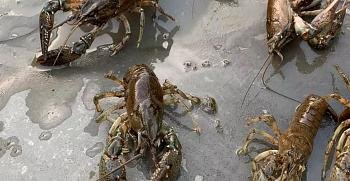Hundreds of crayfish spotted in Toronto river
Toronto rivers are home to all kinds of different wildlife species, many of which are absolutely incredible to spot with the naked eye, and one local resident came across hundreds of crayfish in the Etobicoke Creek this past weekend.
Kimberly LeeAnn Moon was visting Etobicoke Valley Park on Sunday when she noticed hundreds of little crayfish in the river and on surrounding rocks.
Moon sent photos and videos of the freshwater crustaceans, which resemble tiny little lobsters, to blogTO, and she clarified that she simply caught and photographed the little creatures but did not take any of them home.
According to the Ontario government, there are a total of four different species of crayfish that can be found within the province: the native northern clearwater crayfish, the native virile crayfish, the introduced obscure crayfish, and the rusty crayfish.
And while the first three are considered to be fairly harmless and uninvasive, the rusty crayfish is a species known to be large, agressive and invasive.
"Rusty crayfish are commonly found in lakes, rivers, ponds and streams with clay, silt and gravel bottoms that contain rocks, logs or debris the crayfish can hide under. They eat large amounts of aquatic vegetation and their aggressive nature helps protect them from being eaten by native fish," reads the government's informative webpage on the species.
"Females can carry up to 200 fertilized eggs under their tails, enabling a single female introduced to a new area to start a new population. Once rusty crayfish are established, there is currently no practical way to permanently remove them."
Rusty crayfish are native to the Ohio River Basin in the United States, but it's believed that they were likely first introduced to Ontario by anglers from other areas discarding crayfish they were using as bait.
The species may have also arrived in the province after being put in lakes or rivers by people who acquired them as pets or through the scientific supply trade.
The invasive crustaceans were first spotted in the early 1960s in the Kawartha Lakes region, and they're now often spotted throughout much of south-central and southeastern Ontario.
Comments
There are 0 comments on this post








